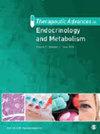糖尿病足骨髓炎截肢患者持续血糖监测衍生时间与截肢主要风险的关系
IF 3.9
3区 医学
Q2 ENDOCRINOLOGY & METABOLISM
Therapeutic Advances in Endocrinology and Metabolism
Pub Date : 2022-01-01
DOI:10.1177/20420188221099337
引用次数: 3
摘要
目的:连续血糖监测(CGM)产生的指标,如范围内时间(TIR),与糖尿病并发症密切相关。本研究探讨了糖尿病足骨髓炎(DFO)患者围手术期CGM衍生指标与主要截肢风险的关系。方法:本研究根据Wagner糖尿病足溃疡分类系统招募了55名3-4级DFO患者,他们在围手术期均接受了为期5天的CGM治疗。CGM衍生的指标是根据最新的国际共识建议定义的。结果:严重截肢患者的TIR显著降低,低于范围时间(TBR)较高(均p < 0.05)。在二元逻辑回归分析中,较低的TIR与严重截肢的风险相关(优势比:0.83(95%置信区间:0.71–0.99),p = 0.039)。在对年龄、性别、体重指数、糖尿病类型、吸烟、饮酒、糖尿病和DFU持续时间、踝臂指数、白蛋白、估计肾小球滤过率、血管外科学会伤口、局部缺血和足部感染(WIfi)阶段、耐多药生物和血红蛋白A1c进行调整后,这种关联仍然具有统计学意义。对血糖偏移平均幅度(MAGE)的进一步调整降低了这种相关性。TBR也与严重截肢的风险独立相关(比值比:1.60(95%置信区间:1.17-2.18),p = 0.003);这种关联在对MAGE进行调整后仍然存在。结论:在DFO住院患者中,围手术期TIR(3.9–10.0 mmol/L)和TBR(<3.9 mmol/L)与重大截肢显著相关。本文章由计算机程序翻译,如有差异,请以英文原文为准。
Association of continuous glucose monitoring-derived time in range with major amputation risk in diabetic foot osteomyelitis patients undergoing amputation
Objective: The metrics generated from continuous glucose monitoring (CGM), such as time in range (TIR), are strongly correlated with diabetes complications. This study explored the association of perioperative CGM-derived metrics with major amputation risk in patients with diabetic foot osteomyelitis (DFO). Methods: This study recruited 55 DFO patients with grade 3–4 wounds according to the Wagner Diabetic Foot Ulcer Classification System, all of whom underwent CGM for 5 days during the perioperative period. The CGM-derived metrics were defined in accordance with the most recent international consensus recommendations. Results: Patients with major amputation had significantly less TIR and higher time below range (TBR) (all p < 0.05). In binary logistic regression analyses, a lower TIR was associated with the risk of major amputation (odds ratio: 0.83 (95% confidence interval: 0.71–0.99), p = 0.039). This association remained statistically significant after adjustments for age, sex, body mass index, type of diabetes, smoking, drinking, durations of diabetes and DFU, ankle-brachial index, albumin, estimated-glomerular filtration rate, Society for Vascular Surgery wound, ischemia, and foot infection (WIfi) stage, multidrug-resistant organisms, and hemoglobin A1c. Further adjustment for the mean amplitude of glycemic excursion (MAGE) reduced this association. TBR was also independently associated with the risk of major amputation (odds ratio: 1.60 (95% confidence interval: 1.17–2.18), p = 0.003); this association persisted after adjustment for MAGE. Conclusion: Perioperative TIR (3.9–10.0 mmol/L) and TBR (<3.9 mmol/L) were significantly associated with major amputation in hospitalized patients with DFO.
求助全文
通过发布文献求助,成功后即可免费获取论文全文。
去求助
来源期刊

Therapeutic Advances in Endocrinology and Metabolism
Medicine-Endocrinology, Diabetes and Metabolism
CiteScore
7.70
自引率
2.60%
发文量
42
审稿时长
8 weeks
期刊介绍:
Therapeutic Advances in Endocrinology and Metabolism delivers the highest quality peer-reviewed articles, reviews, and scholarly comment on pioneering efforts and innovative studies across all areas of endocrinology and metabolism.
 求助内容:
求助内容: 应助结果提醒方式:
应助结果提醒方式:


